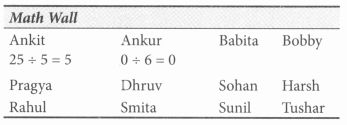KTET Paper 1: Mathematics Test - 7 - KTET MCQ
30 Questions MCQ Test KTET Mock Test Series 2024 - KTET Paper 1: Mathematics Test - 7
Rizul is a kinesthetic learner. His teacher Ms. Neha understood his style of learning. Which of the following strategies should she choose to clear his concept of multiplication?
| 1 Crore+ students have signed up on EduRev. Have you? Download the App |
In which of the following statements, number 'two' is used in ordinal sense?
A teacher asked her students to find out the last term of the sequence 1, 1/2, 1/4, 1/8. This question will test the ______ of the students.
The objective of teaching number system to Class III students is to enable the students:
A teacher wants to teach about fractions, what is the best method to introduce fractions to learners?
"To appreciate the works of a mathematician" corresponds to which value?
From the unit of 'Shapes', the teacher asked the students to make/draw any picture by using shapes. The objectives that can be achieved through this activity is
Which of the following is the most important aspect of teaching of mathematics at primary level?
After teaching the concept of division, a teacher created a 'Mathematical wall' in the classroom and asked the students to write any two division facts in the assigned columns within 48 hours:

This activity can help the teacher to:
Mensuration integrated with geometry makes drawing of regular shapes introduced to children in four ways -
1. aesthetic
2. approximation
3.comprehensive
4. association
This is known as ________.
Then teaching addition of fractions, a teacher came across the following error:
1/2 + 1/3 = 2/5
What remedial action can the teacher take in such a situation?
Identify the correct statement with regard to introducing the concept of fractions at primary level.
Mathematics is often referred to as the science of
Method that can be used to prove, square of an odd number is also odd:
Pradeep was shown a broken ruler and asked where is 5 cm on the ruler. He picked up the ruler and pointed out the mark of 5 cm on the ruler. His answer_____.
Aryabhatt was a great Indian mathematician, he was born in
Piaget believed that learning results from social instruction, and a Mathematics teacher believing in Piaget's theory shall use
Sequence the following tasks as they are taken up while developing the concept of measurement:
I. Learners use standard units to measure length.
II. Learners use non-standard units to measure length.
III. Learners verify objects using simple observation
IV. Learners understand the relationship between metric units.
A child cannot differentiate between the symbols of '+' and '×' symbols. She needs
Which of these activities is/are involved in laboratory method of learning mathematics?
Manipulative models, static pictures, written symbols, spoken and written language, real-world situations, or contexts are five ways to represent:
The devices which are used to make teaching methods more effective are known as
|
100 tests
|


















